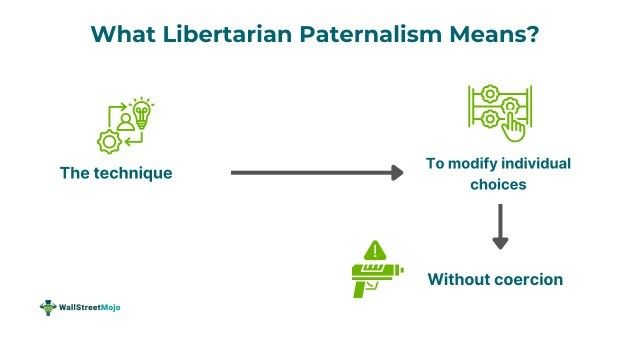Table of Contents
What Is Libertarian Paternalism?
Libertarian Paternalism refers to a middle path curated between two extreme paths to influence an individual's choices, keeping their free will intact. It aims to nudge individuals often by modifying the choice structure towards making the best decisions without coercion in sensitive sectors like finance and health for individual welfare.

It respects individuals' autonomy through a balanced approach to help them avoid suboptimal choices because of limitations and cognitive bias. It has increased the number of individuals opting for retirement savings plan enrollment independently. It does not stifle individual freedom while inculcating and nurturing beneficial behavior in individuals.
Key Takeaways
- Libertarian paternalism represents the middle route carefully crafted to influence people's decisions while preserving their power of free will.
- It frequently seeks to nudge people to make the best choices for their welfare in delicate sectors like finance and health without using force but altering the choice structure.
- It relates to the influence exerted by institutions on individual behavior while respecting their freedom of choice.
- Nudging concerns the modification of choice architecture to impact individual decisions without force.
Libertarian Paternalism Explained
Libertarian paternalism helps people make good, beneficial choices while keeping their choice-making freedom intact. It can be stated as combining the vital aspects of paternalism and libertarianism to advocate for activities for individuals. Libertarian paternalism behavior makes it legitimate and possible for organizations to lightly push people towards helpful options while retaining their choice-making freedom. It works by guiding choices to the best interest with subtle nudges without curbing options.
It uses choice architecture to nudge people direct to behave in a certain manner without limiting their choices. It also assumes that individuals have like-mindedness, similar conditions and desires of welfare. Hence, governments can use its premise to promote individual welfare without violating rights. Nevertheless, it has certain negative implications as it can harm people not fitting their nudges assumptions or have special situations making nudges ineffective.
It has improved individual decision-making related to education, retirement and health, even without any force or coercion. Libertarian paternalism in economics addresses cases where people fail to act correctly and in their best interest because of cognitive biases. Corporate governance and policymaking have taken help from such an approach to increase public participation in social welfare programs. In the financial sector, companies have added some beneficial schemes to people like investment options in saving accounts.
It has encouraged and improved financial behavior amongst people to have better credit management. Its strategies are executed in diverse fields, like minimizing smoking rates using graphic warnings, campaigning for energy savings, and promoting the use of green energy by users. Other than these, policymakers have been impressed with its non-coercive nature and flexibility nudges on individual behavior.
Examples
Let us use a few examples to understand the concept:
Example #1
Check out this article that suggests that the current political scene in India is that of Libertarian paternalism. The article says that while electoral participation in India increases, making it more democratic than ever, there is a shift towards a more authoritarian form of governance, a trend that has been visible since the current ruling party came into power. At the same time, this authoritative governance can instill fear in people, making electoral participation and, thus, the practice of free will more active. But there is a simultaneous weakening and polarization of institutions along with the enhancement of democracy, keeping the people of India in a Libertarian Paternalism dilemma.
Example #2
Let us assume that Old York City's local government wants to constructively improve public hygiene without curbing their independence of thought. Therefore, the city council initiated an opt-in-hygiene health program, encouraging residents to take part in free health checkups on Sundays and installing napkin points at crossroads. The health committee of Old York City sends personalized letters to every city resident and invites them to participate for better health, saving medical expenditure and long live.
They were also promised weekly prizes for attaining the goals assigned to them regarding the hygiene program. However, individuals were also informed that they could opt out of the program anytime they liked, but nudged them regarding the benefits. After one week of operationalizing the hygiene program, the city council observed that 50% percent of residents participated. Meanwhile, doctors also reported a 15 % drop in patients related to common ailments from a lack of hygiene. Hence, the program became successful without curbing or mandating anyone but rather through nudging only.
Libertarian Paternalism vs Nudging
Let us use the table below to understand their differences:
| Libertarian Paternalism | Nudging |
|---|---|
| It relates to the influence exerted by institutions on individual behavior while respecting their freedom of choice. | Concerns the modification of choice architecture to impact individual decisions without force. |
| Suggests nudging instead of banning or restricting, and centering on gently persuading. | Consist of systematic execution of nudging to initiate changes in behavior. |
| Individuals can retain their choice while opting out of interventions and conserving autonomy. | Potential to change the choices made in an altered context incorporating the freedom to choose. |
| Individuals could judge the improved welfare they get. | Changes the environment a little subtly to promote wise decision-making. |
| Instances include the default option added to retirement plans. | Keeping healthier food at eye level in work places. |
